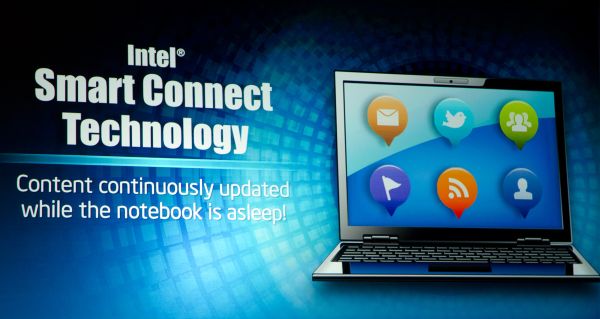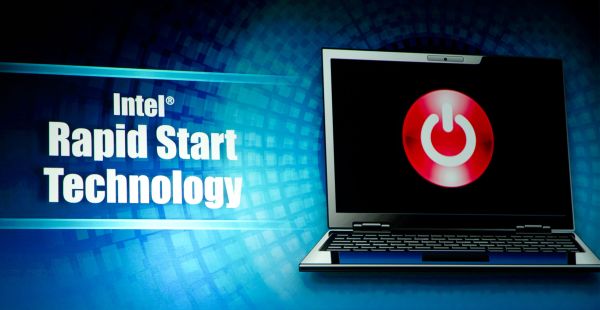New Intel Marketing Terms: Smart Connect & Rapid Start Technology
by Anand Lal Shimpi on May 31, 2011 3:38 AM EST- Posted in
- Laptops
- Intel
- Computex 2011
- Trade Shows
- Ultrabook
In our Ultrabook article from earlier this evening I mentioned that Intel would be enabling a new technology with Ultrabooks that allows your applications that require real time updates (e.g. email, twitter) to keep receiving data even when your PC is asleep. In its opening keynote at Computex, Intel shed some more light on the technology.
It's called Intel's Smart Connect Technology. Using a software layer it'll periodically wake up your machine while in a sleep state to check for updates for things like email, Twitter, Facebook, etc... My guess is the software will just reactivate the network connection at a not-short interval so those applications can get updates. The result will be a machine that seems like it's been connected and constantly receiving updates while it was asleep.
Smart Connect Technology will debut in some Ultrabooks shipping at the end of this year, but with Ivy Bridge the technology will move to a push model instead of a pull model - which should be better for battery life.
The next technology is called Rapid Start. Rapid Start is simply hibernate to NAND, which allows your notebook to resume from a zero-power hibernate state in 5 - 6 seconds.
Expect both features in Ultrabooks starting at the end of the year.












18 Comments
View All Comments
coburn_c - Tuesday, May 31, 2011 - link
sounds like a re purpose of the Intel AMT tech, bringing hardware back-doors to the mainstream ey intelGeorgeH - Tuesday, May 31, 2011 - link
If the machine is asleep, then I see no reason to process data (there's no user there to read or act on anything.) What's wrong with simply getting a data dump once when the machine comes back from sleep?Keeping data up to date on a smartphone makes sense - you're pulling it out of your pocket for half a second to check things then put it back - but for a laptop I really don't get it. It sounds like clueless upper-manager nonsense; they're solving a problem that doesn't exist simply because the "cool" smartphone guys are doing the same thing.
JasonInofuentes - Tuesday, May 31, 2011 - link
If you relish the idea of the continuous client (a means of maintaining a consistent state across all platforms so that you can resume work on a document, chat and game session, for instance, on your laptop after walking away from your desktop) then this is a key component.The continuous client is logical on the smartphone but for it to be productive it has to be usable across PC's as well, and this technology could make that a reality.
jcompagner - Tuesday, May 31, 2011 - link
that are quite a lot of GB of data writes each day then.I don't do hibernate on my Vertex 3 240GB because that would cause at least twice a day a write of 12GB or ram.... Thats a write of 24GB a day purely to do hibernation. Now i have 240GB SSD so in 10 days i would have written all the cells once, so yes for such a drive i could do that for quite a while. But i guess Intel talks about some special NAND thats the size of the memory? Wouldn't that wear out the cells very quickly?
If i just look at my usage through the OCZ toolbox smart data:
power on hours: almost 600
data written: 1060GB
data read: 1600GB
so my write to read ration is already quite high. Doing hibernate every day, 2 times a day then my writes would even be bigger then my reads...
piroroadkill - Tuesday, May 31, 2011 - link
It could just be an SLC NAND module that's relatively small. 8GB of SLC just for hibernation wouldn't cost all that much to replace, and would last a lot longer than MLC. Plus, it wouldn't be storing data you give a shit about.camylarde - Thursday, June 2, 2011 - link
Umm, every bit that you write during hibernation will get read again next time? Your writes will stay in proportion to the reads.kanabalize - Tuesday, May 31, 2011 - link
But still no <20 second boot time??How to achieve this?
MrCromulent - Tuesday, May 31, 2011 - link
Hm? I've got 19s boot time to Windows with my cheap Sandforce SSD and my cheap AMD Athlon X4 right now...Yota999 - Tuesday, May 31, 2011 - link
You don't need to boot a system if you have a fast way to hibernate.Yota999 - Tuesday, May 31, 2011 - link
Who cares about boot when you can resume in 5s from a zero power state?